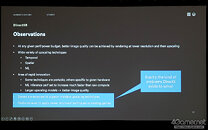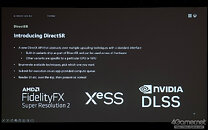- Joined
- Oct 9, 2007
- Messages
- 46,476 (7.66/day)
- Location
- Hyderabad, India
| System Name | RBMK-1000 |
|---|---|
| Processor | AMD Ryzen 7 5700G |
| Motherboard | ASUS ROG Strix B450-E Gaming |
| Cooling | DeepCool Gammax L240 V2 |
| Memory | 2x 8GB G.Skill Sniper X |
| Video Card(s) | Palit GeForce RTX 2080 SUPER GameRock |
| Storage | Western Digital Black NVMe 512GB |
| Display(s) | BenQ 1440p 60 Hz 27-inch |
| Case | Corsair Carbide 100R |
| Audio Device(s) | ASUS SupremeFX S1220A |
| Power Supply | Cooler Master MWE Gold 650W |
| Mouse | ASUS ROG Strix Impact |
| Keyboard | Gamdias Hermes E2 |
| Software | Windows 11 Pro |
Microsoft revealed that its DirectSR (Direct Super Resolution) API, which seeks to standardize super resolution-based performance enhancement technologies in games, has a hardware-independent default code path that is essentially based on AMD FSR 2.2, a Microsoft Dev Manager speaking at GDC has revealed. DirectSR provides a common set of APIs for game developers to integrate super resolution—so that developers don't have to separately implement DLSS, FSR and XeSS. Rather these upscalers, and others, can register themselves with the DirectSR API, and then get fed a dozen of input parameters that they may (or may not) use to improve the upscaling quality. Since AMD has open-sourced the code of FSR 2.2 on GPUOpen, and it is entirely shader-based, and doesn't use exotic technologies such as AI, Microsoft decided to use FSR 2.2 as the base algorithm for DirectSR. If other algorithms like DLSS are available on the user system, these can be activated by the user, too, of course, but supporting them requires no extra work from the developer side.




Update 18:15 UTC: Updated the news post to make it clear that the FSR 2.2 code path is merely a default, and other upscalers are free to hook into DirectSR to provide upscaling.
View at TechPowerUp Main Site | Source




Update 18:15 UTC: Updated the news post to make it clear that the FSR 2.2 code path is merely a default, and other upscalers are free to hook into DirectSR to provide upscaling.
View at TechPowerUp Main Site | Source





